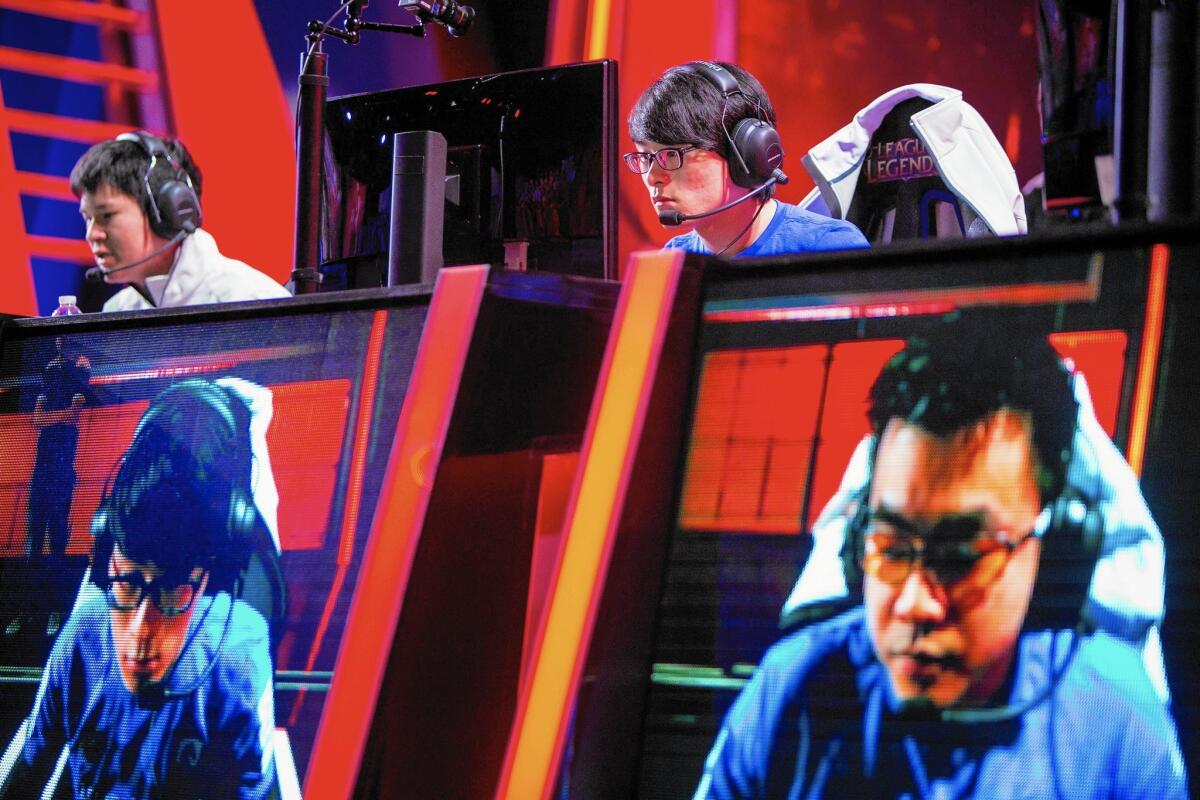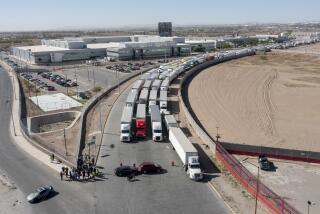Chinese investments in U.S. businesses are accelerating

Tencent Holdings Ltd., a Chinese firm, bought a majority stake in video-game maker Riot Games in 2011 for $250 million. Above, a video game competition at Riot’s L.A. studio.
- Share via
Chinese investments in U.S. businesses, all but nonexistent 15 years ago, now total nearly $50 billion and could reach $200 billion by the end of the decade, according to a new study tracking the accelerating trend.
Rising energy and labor costs in China have helped to push the trend toward direct U.S. investments by Chinese individuals and companies over the last five years, said the study by global research firm Rhodium Group and the nonprofit National Committee on U.S.-China Relations.
Chinese investors have bought or created 1,583 U.S. companies over 15 years through December that now employ 80,600 full-time workers after a five-fold increase in the last five years.
------------
FOR THE RECORD:
Chinese investments: In the May 20 Business section, an article about Chinese investment in U.S. businesses referred in one instance to the total potentially reaching $200 million by the end of 2020. As the article correctly said in another reference, total investment could reach $200 billion, not million. The article also misidentified a U.S. subsidiary of Alibaba Group Holding as 11 Main Street. It is 11 Main Inc.
------------
California was the top destination as Chinese investors put $5.9 billion into almost 370 businesses that provide about 8,300 jobs, mostly in the Los Angeles and San Francisco metropolitan areas.
The fast-rising investment pales in comparison to three decades of far greater flows of U.S. capital into Chinese manufacturing, and China’s direct investments in U.S. companies still are far from those made by a host of other countries.
Still, Chinese purchases and start-ups should deepen ties in ways that mere purchases of foreign products cannot do, said Stephen A. Orlins, the National Committee’s president.
“Investment brings people together. Trade, less so,” he said.
That’s an easier argument to make to a mayor in Alabama or a governor in California than to many politicians in Washington, said Thilo Hanemann, Rhodium’s director of research.
On Wednesday, Mayor Sheldon Day of Thomasville, Ala., is scheduled to describe at a New York news conference on the study how Golden Dragon Precise Copper Tube Group helped revive his depressed region of muddy roads, pine forests and shuttered textile and furniture factories. The company, based in China’s Henan Province, built a $100-million manufacturing facility that employs 300 workers.
Elsewhere, Chinese investors have been largely welcomed at new and existing firms.
In West Los Angeles, more than 1,000 employees, called rioters, labor at online video-game producer Riot Games, the maker of the popular “League of Legends” game. Chinese Internet company Tencent Holdings Ltd. bought a majority stake in the firm in 2011 for $250 million.
In eastern Virginia, Shuanghui International Holdings of Hong Kong spent $4.7 billion two years ago to buy Smithfield Foods Inc., the largest U.S. pork producer with 3,700 employees just in the state at the time.
In Chico, Calif., Chinese online commerce giant Alibaba Group is employing 130 people at its fledgling online U.S. retailer, 11 Main Inc.
Jeffrey Towson, a Peking University investment professor, said Chinese outbound direct investment activity is still in its relative infancy. As China’s economy slows and it tries to curb over-investment in ports and roads and other infrastructure, state-owned enterprises in sectors such as railways and construction are looking to go abroad.
“The government is giving them a big push to go international,” he said. He cited as an example China’s recent bid for a high-speed rail project in Mexico, which was initially approved but later fell through.
China’s outbound investments began only in the early 2000s, Towson said, and until the last five years, almost all of it was focused on natural resources, such as acquiring mining assets in areas like Latin America. That’s starting to slowly change, he said.
Rhodium’s study stems from its desire to get a clearer picture of foreign investments in the U.S. Its study doesn’t count deals in progress, only completed transactions. It also traces the money that China says flows into Hong Kong, a semi-autonomous Chinese city, to show how much of it often ends up in investments elsewhere.
The study includes Chinese investments in large-scale real estate but not residential real estate — a hot market in California for Chinese millionaires — or construction projects because those jobs aren’t permanent.
The Chinese are the top foreign buyers of U.S. homes, spending $22 billion on residential real estate from April 2013 to March 2014, according to the National Assn. of Realtors. About 51% of reported purchases were in California, Washington and New York.
The Chinese Ministry of Commerce reported that the nation’s total foreign direct investment in 2013, the latest year for which statistics are available, was $107.8 billion, making it the third largest in the world behind the U.S. and Japan.
But it calculated outflows to the U.S at just $3.9 billion, only 3.6% of the total and 4.3% lower than the previous year.
And according to U.S. statistics, U.S. companies and entrepreneurs have accumulated nearly $6.35 trillion in total foreign direct investments over its much longer history of such deals, compared with China’s $660 billion. China still ranks behind Britain, Germany, France, Hong Kong and Japan in total accumulated direct investments, though it is rapidly moving up the ranks.
The U.S. Bureau of Economic Analysis statistics show that China accounted for less than 1% of all foreign investment from 2010 through 2013. South Korea had more than twice the volume, Japan 13 times more and Britain spent 18 times as much buying U.S. business operations or starting new ones.
Those figures understate the outflow from mainland China because they miss certain investments made through Hong Kong or other offshore locations, Rhodium’s Hanemann said.
Such statistics are “the main reason” why Rhodium built its own database of deals, he said.
The study’s approach is conservative, Hanemann said.
For example, counting only full-time jobs understates the effect of deals such as Chinese conglomerate Dalian Wanda’s $2.6-billion purchase of a majority stake in theater chain AMC Entertainment Holdings Inc. in Leawood, Kan. As of Dec. 31, AMC had about 900 full-time employees and 18,800 part-timers, the company said in a recent regulatory filing.
Deals such as Hunan TV and Broadcast’s recent agreement to provide one quarter of the expected $1.5 billion in production costs at film studio Lionsgate over the next three years also are excluded because as a partnership, the deal doesn’t result in a Chinese company owning most of the physical assets in this country.
Indeed, there are Chinese and U.S. entertainment partnerships, mergers and acquisitions that may not meet Rhodium’s definition of direct foreign investment, said Bennett Pozil, executive vice president at East West Bank.
“There is a lot going on, from co-production to investment on the project side as well as partnerships, ventures and investments on the [merger and acquisition] side,” said Pozil, who specializes in entertainment lending between the U.S. and greater China.
Overall, the Rhodium report said investment in California is spread across a wide range of industries, with a focus on high tech in San Francisco and Silicon Valley.
The Los Angeles metro area is a magnet for large real estate investments, such as Dalian Wanda’s purchase of the site of the former Robinsons-May department store in Beverly Hills and Shenzhen New World Group’s purchase of the Sheraton Universal Hotel and the Los Angeles Marriott Downtown.
Downtown L.A. also hosts two major new mixed retail-residential complexes being built by Chinese developers, Greenland Group’s Metropolis project and Oceanwide Real Estate Group’s Fig Central, with total investment of nearly $2 billion.
Whether total Chinese direct investment in the U.S. surges to as high as $200 billion by the end of 2020 will depend, in part, on the slowdown in China’s booming economy. If it stagnates or shrinks, Chinese companies might slow down or cash out their investments in the U.S. to shore up domestic operations, said Orlins at the National Committee.
But should growth continue, only at a slower pace, “China becomes a relatively less attractive destination for capital,” and the U.S. could look more enticing, Orlins said.
Reckard reported from Los Angeles; Makinen from Beijing.
More to Read
Inside the business of entertainment
The Wide Shot brings you news, analysis and insights on everything from streaming wars to production — and what it all means for the future.
You may occasionally receive promotional content from the Los Angeles Times.












